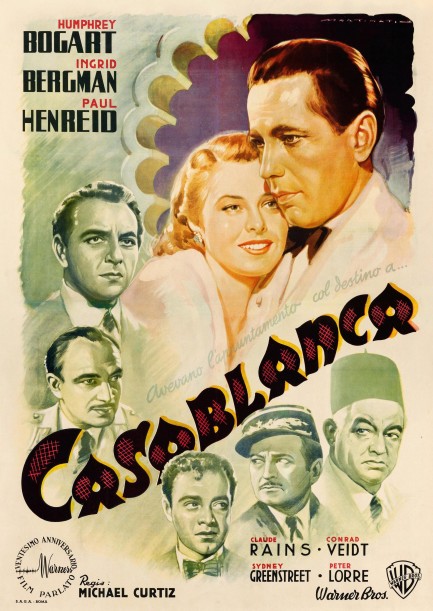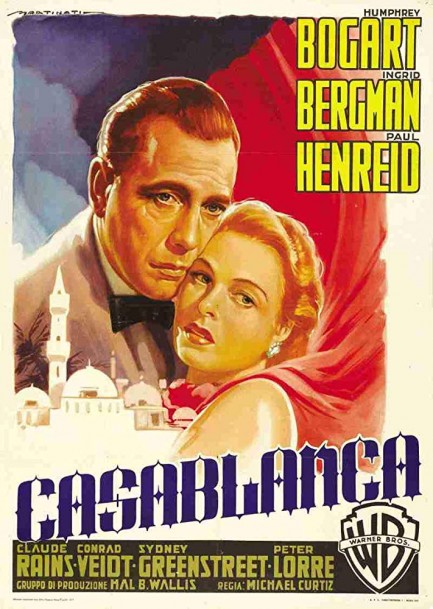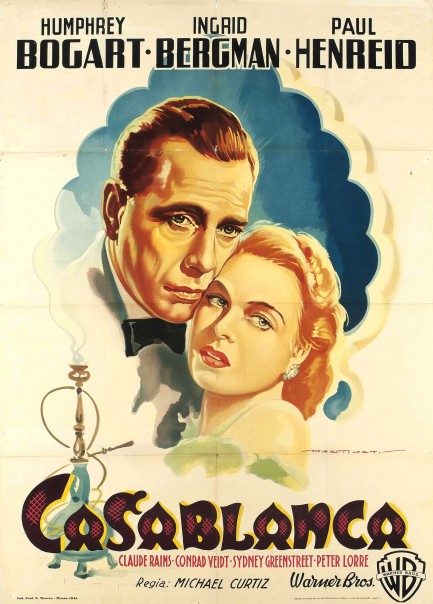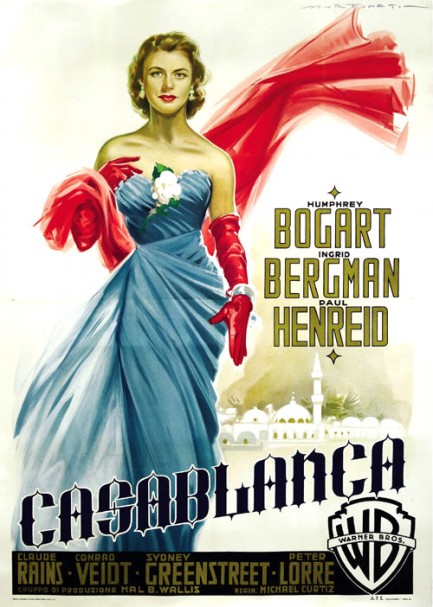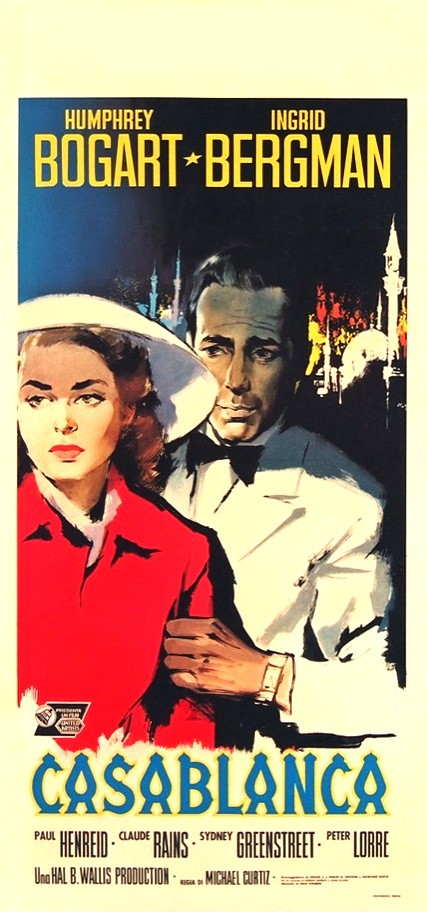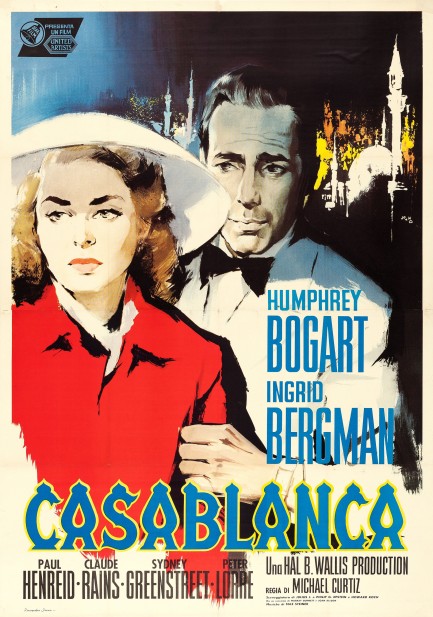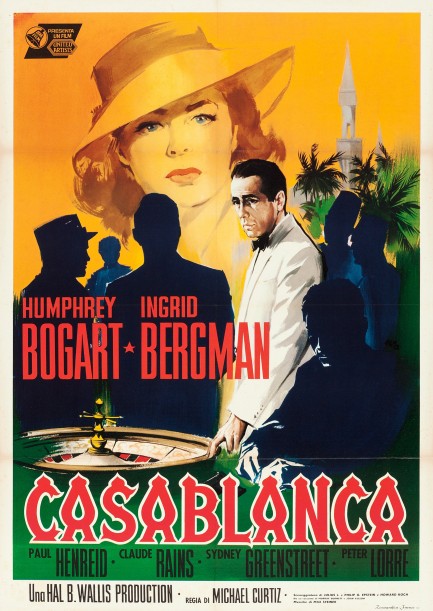 The fundamental things apply. 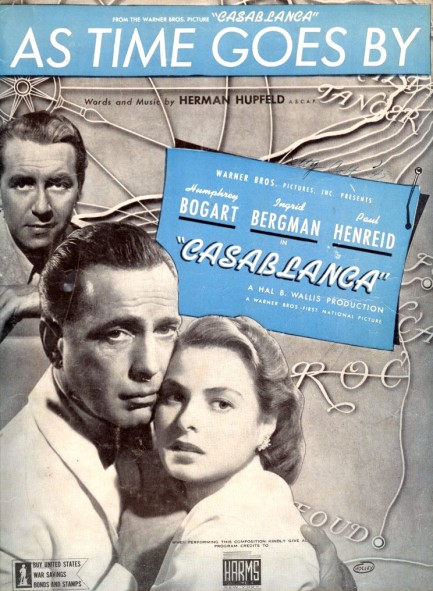
Here’s something nice we ran across on an auction site. It’s a piece of sheet music for “As Time Goes By”, which is a song written by German composer Herman Hupfeld and sung by Dooley Wilson’s character Sam in 1942’s Casablanca. The tune is inextricably identified with the film, but it was actually written for the 1931 Broadway show Everybody’s Welcome, where, in its complete form, it becomes clear the song is just as much about stress as about romance. You wouldn’t know that of course, because you don’t know the lyrics—really, who does? But today’s your lucky Monday—you can brush up on the words here. Just remember these two music fundamentals: if you sing, please do so from the diaphragm; and if you sing badly, blame it on booze.
 Bogart may own the café, but Bergman owns the room. 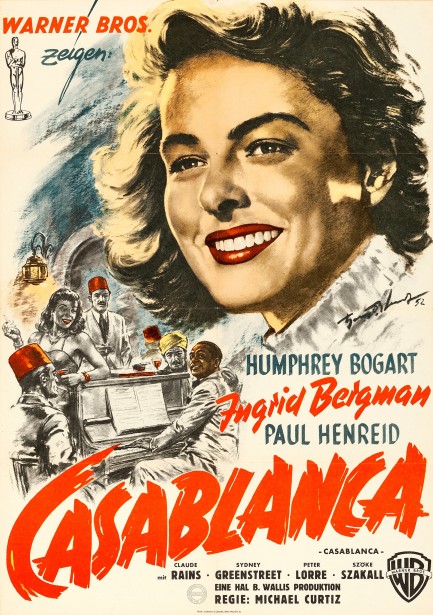
Since we're checking out European poster art today, above is a nice West German promo for the classic wartime drama Casablanca, with Humphrey Bogart and Ingrid Bergman. We've covered just about all the nice promos for this film: Japanese, Spanish, Italian, and of course the classic U.S. version. Plus we wrote a post about the movie's brilliant set design. But this additional poster is worth sharing because it's the first time we've featured artist Hans Otto Wendt, a well regarded figure who worked during his youth as a draftsman in the newspaper industry, before taking his talents afield and collaborating with Deutsche London Film, Warner Bros., Twentieth Century Fox, and other major studios. He worked until 1969, at which point he retired due to poor health, and finally died in Berlin in 1979. For the above effort, note that he not only made Bergman the star of the poster, but the star of his handpainted lettering too. Casablanca premiered in West Germany today in 1952.
 Thanks to the memorabilia market you can buy a new identity without breaking the law. 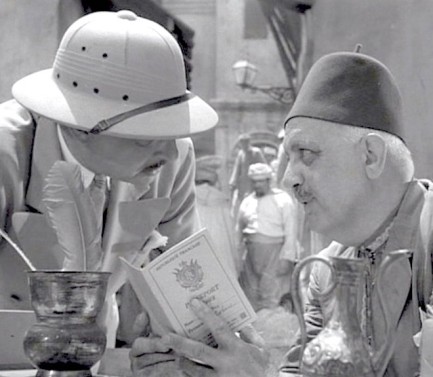
Okay, film buffs—can you identify the movie from which the above frame is taken? We're betting a good percentage of you knew it even before you read the question. It's Casablanca, and we're sharing the image because it shows one of the prop passports used in the film. The most important of those passports belonged to Czech resistance figure Victor Laszlo, played by Paul Heinreid. Props of that type are big items for movie memorabilia collectors, and few collectibles are more popular than those from Casablanca.
Below you see the cover and some interior pages of one of the actual prop Lazslo passports made for the movie, complete with Heinreid's photo and various official-looking visa stamps. There's disagreement on the spelling of Laszlo's name—the prop says Laslo, on AFI.com it's Lazlo, and on IMDB it's Laszlo. The movie was made before end credits were a thing, so you can't find out there. A script would settle it. Maybe that'll be auctioned next. Anyway, this passport was auctioned a while back, and incredibly—or perhaps not—went for $12,500. You know our rule. Actually it's two rules: Never pay more for something than a flight to Paris costs; and never pay a lot for anything that can be used to swat a fly. Of course, if you've seen the movie you know the dox of crucial importance are really the letters of transit everyone desperately wants. We've added one of Victor Laszlo's feuilles de déplacement (which says Laszlo) at bottom. It was auctioned too, but the passport went for more.
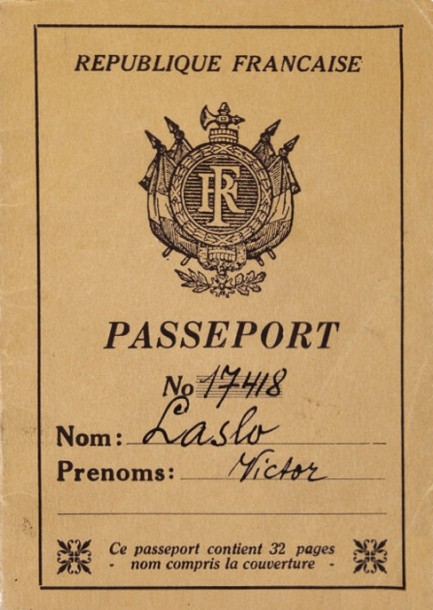 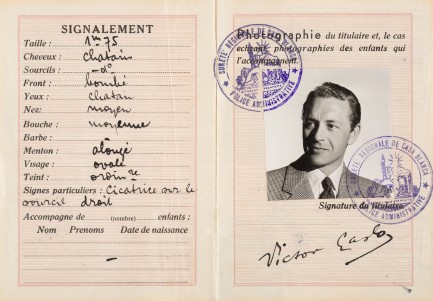 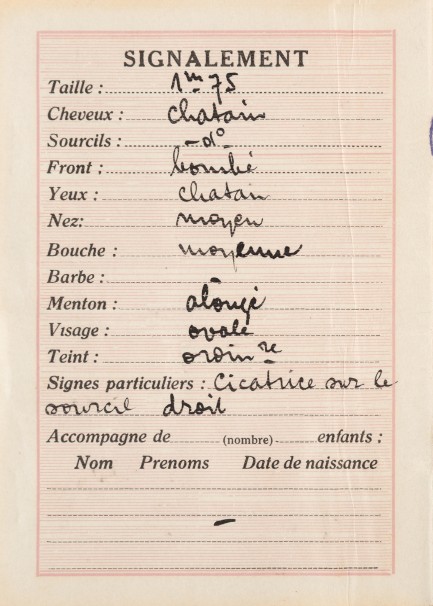 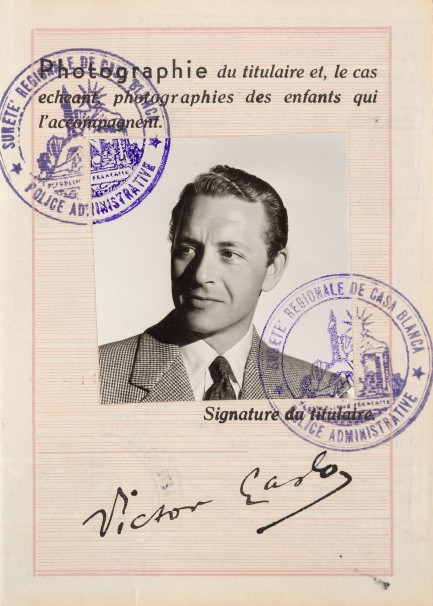 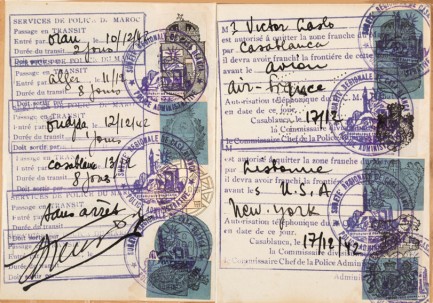 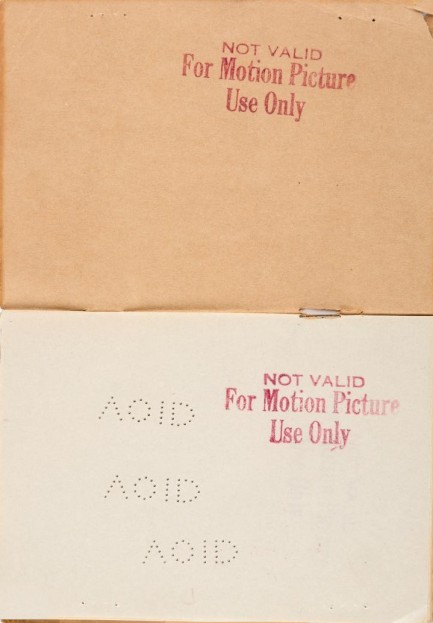 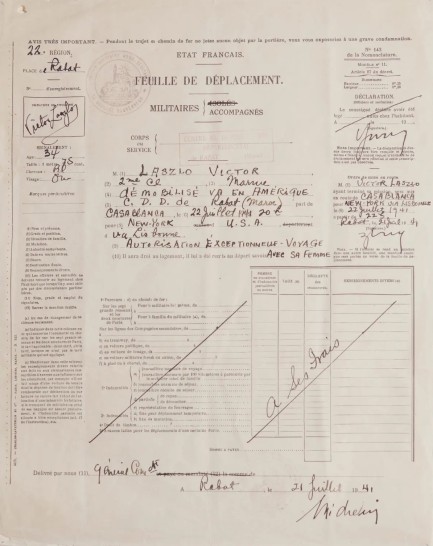
 Who needs a piano player when you have Maxell? 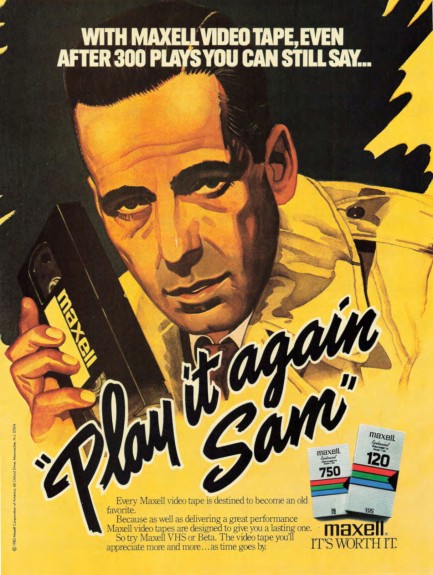
We've never quite been able to wrap our heads around the idea that dead stars can be made to advertise products, but hey, capitalism. Above is an advertisement we ran across featuring Humphrey Bogart in his role as Rick from Casablanca, shilling Hitachi's Maxell videocassettes. This is from 1983. We'd have put this in our pulp advertising feature in the sidebar, but that gadget froze us out years ago. Due to some coding glitches we can neither add nor subtract from there. It's yet another reason for the long promised site redesign that's still tops on the list of things to do (except for traveling, hitting bars and beaches, and hanging with PI-1 & PI-2). Maybe in 2023 it'll actually happen. Hell, if Bogie can embrace the new, so can we.
 In Casablanca no other place compares. 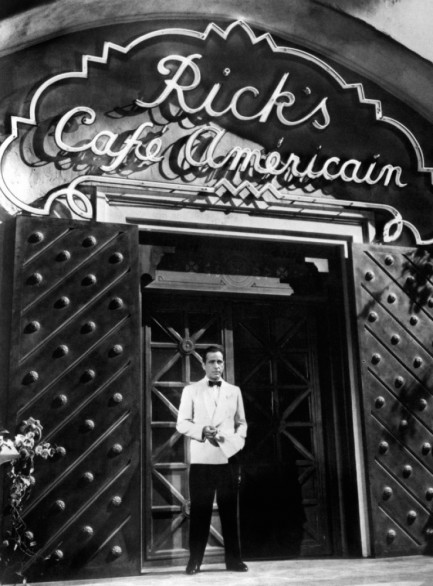
We're back in the house today—Casablanca, that is. Several days ago, on the film's Italian premiere date, we showed you some Italian posters, and today, on its U.S. premiere date, we're taking a close look at possibly the most famous fictional bar in cinema history—Rick's Café Americain. Casablanca is one of the greatest films ever made, and it's fair to say Rick's was a supporting character. Filmgoers of 1942 found themselves steeped in its otherworldly Moroccan atmosphere, as scenes were staged in its courtyard, dining room, gambling room, at its lively bar, and in Rick's roomy upstairs office and personal living quarters. We've never confirmed this, but we suspect one third of the film occurs inside Rick's Café. We have photos of every area we could find of this iconic and exotic “gin joint”—as Bogart cynically describes it—and we even turned up a blueprint.
You'd be tempted to think bars like Rick's exist only in film, but you'd be wrong. We've been to places that have exotic architecture, excellent food and drink, lively musical entertainment, well dressed international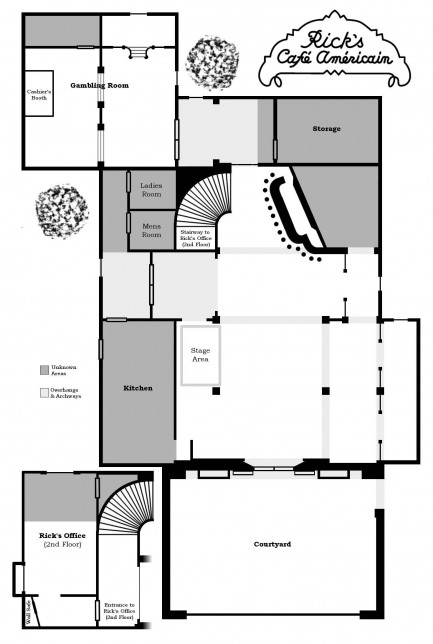 clientele, and the aura of being in the middle of a spy caper. The decadent colonial bar Abaco, located in Palma de Mallorca, comes immediately to mind, as does the supper club Meson Pansa Verde in Antigua, Guatemala, where they have live jazz in a converted wine cellar and a friend of ours once famously pushed his date into the pool. We've been to Rick's-like places in Mexico, the Caribbean, the Greek Islands, and, appropriately, Morocco, in both Fes and Marrakech (we're not fans of the Rick's that currently operates in Casablanca—same name, very diminished feel). But magical places do exist, which means even if Bogart's beloved café was never real, having those types of nights is possible. We recommend making it your mission to seek them out. clientele, and the aura of being in the middle of a spy caper. The decadent colonial bar Abaco, located in Palma de Mallorca, comes immediately to mind, as does the supper club Meson Pansa Verde in Antigua, Guatemala, where they have live jazz in a converted wine cellar and a friend of ours once famously pushed his date into the pool. We've been to Rick's-like places in Mexico, the Caribbean, the Greek Islands, and, appropriately, Morocco, in both Fes and Marrakech (we're not fans of the Rick's that currently operates in Casablanca—same name, very diminished feel). But magical places do exist, which means even if Bogart's beloved café was never real, having those types of nights is possible. We recommend making it your mission to seek them out. 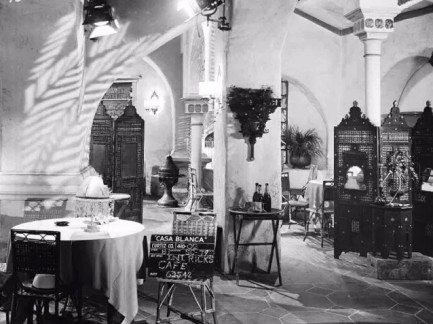 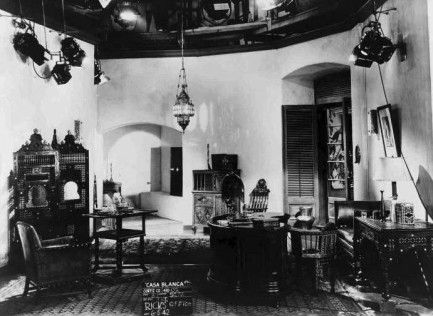 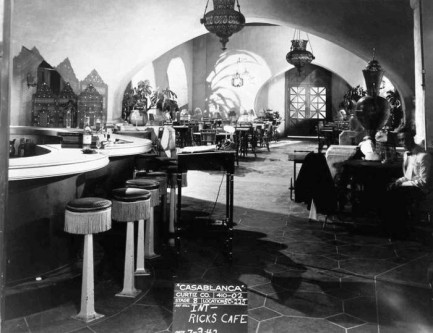  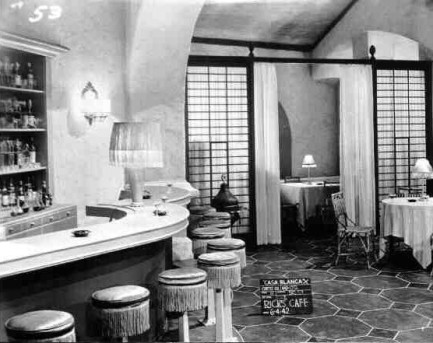 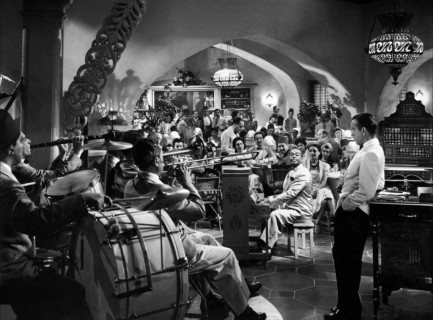 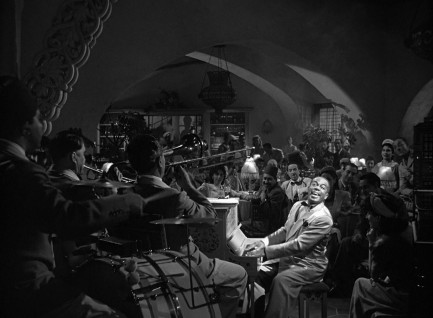 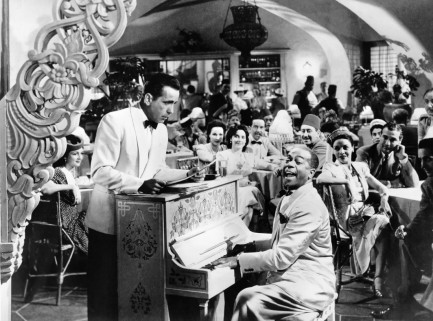 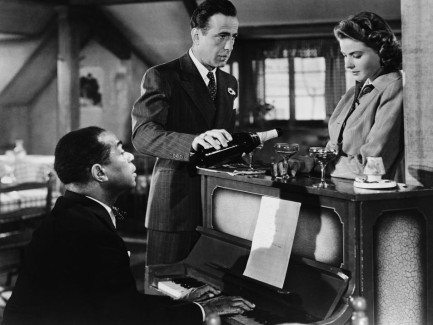 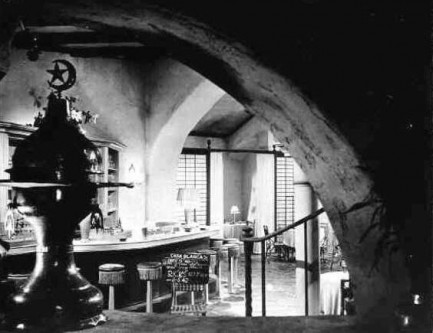 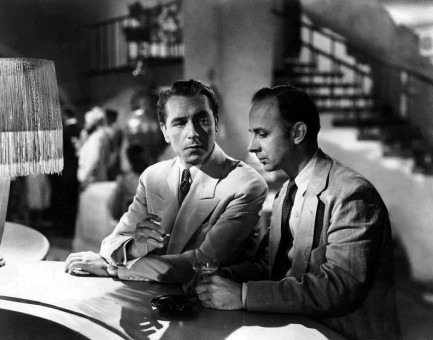 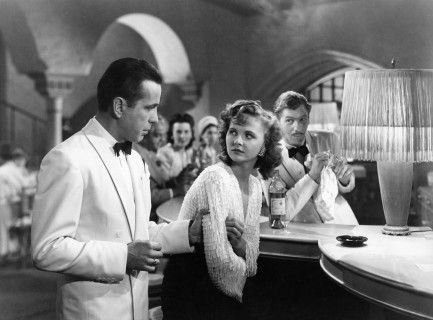 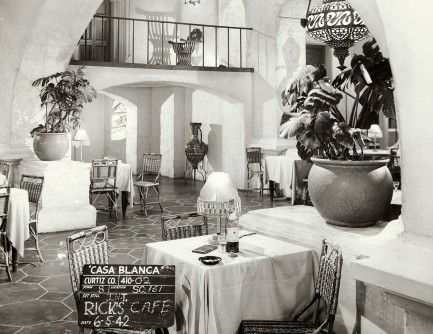 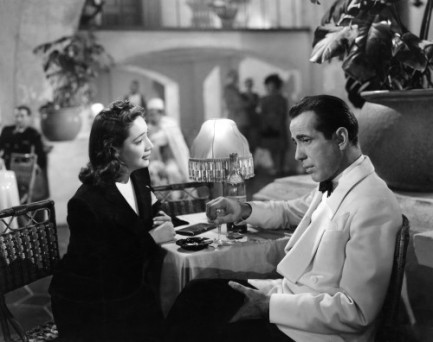 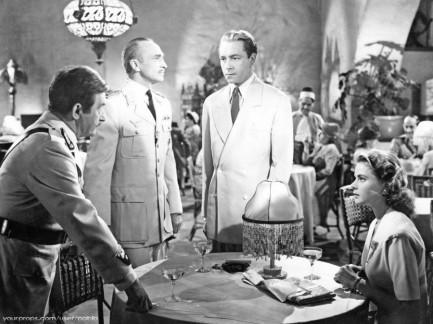 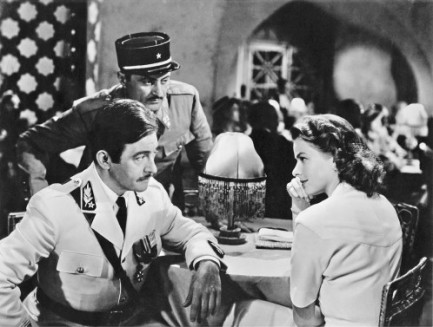 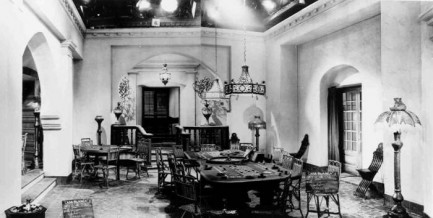 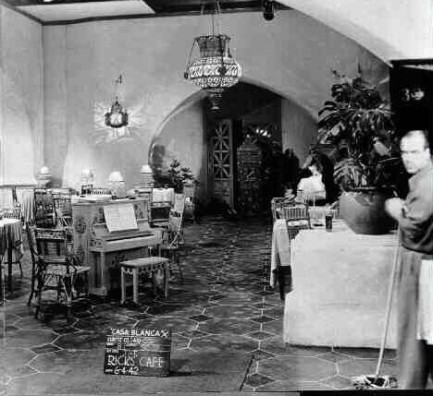 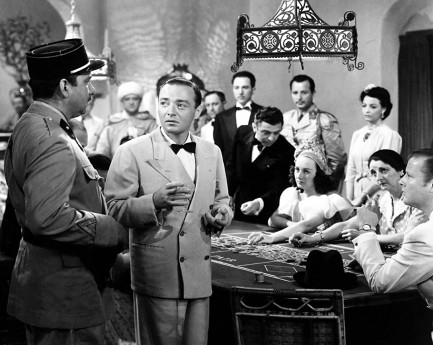 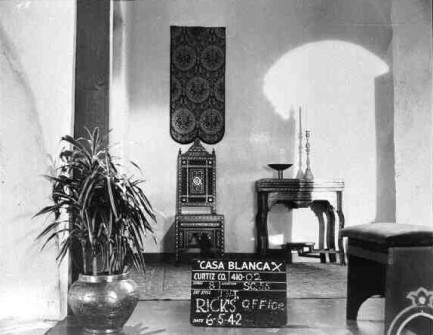  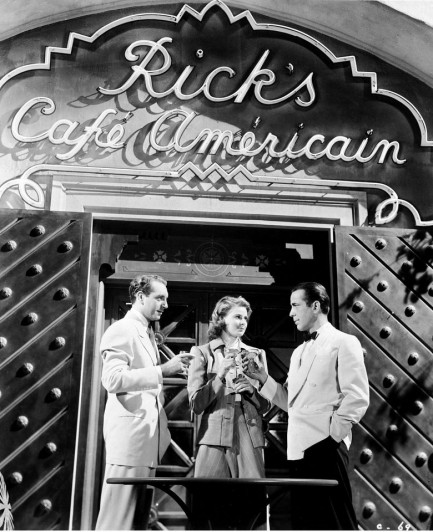
 The FBI stretches its jurisdiction all the way to Morocco in 1953 thriller. 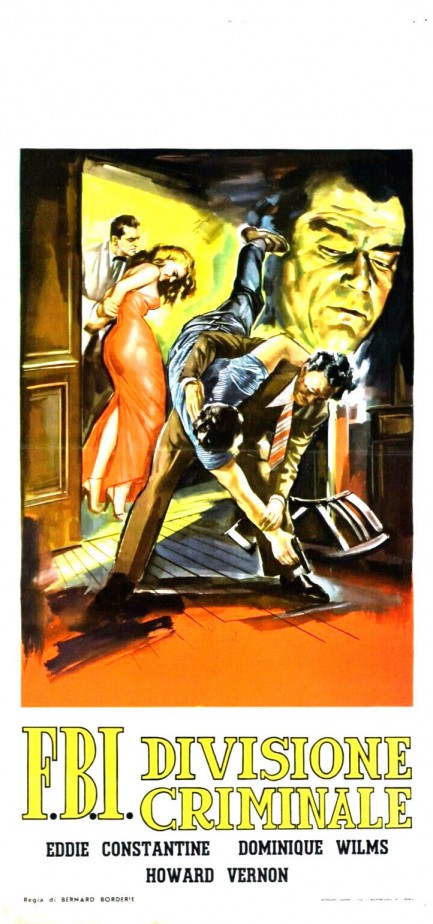 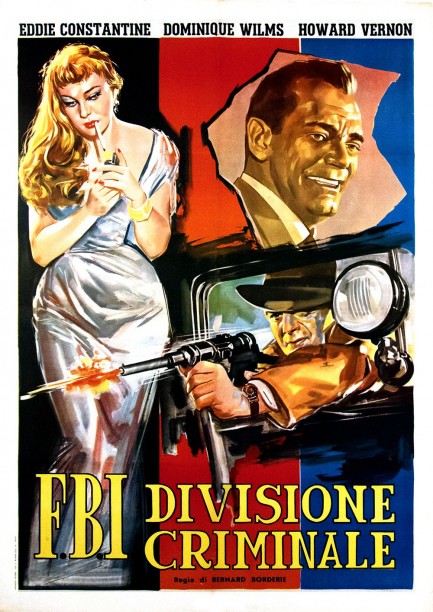
Above, two beautiful Italian posters for F.B.I. divisione criminale, originally titled La môme vert de gris, but known in the U.S. as Poison Ivy. The film was based on a Peter Cheyney novel also named Poison Ivy, and starred Eddie Constantine as an American G-man in Morocco, and Dominique Wilms as a femme fatale known as—you guessed it—Poison Ivy. We talked about the movie at length in May, so if you're curious have a look here.
 French crime drama throws Caution to the wind. 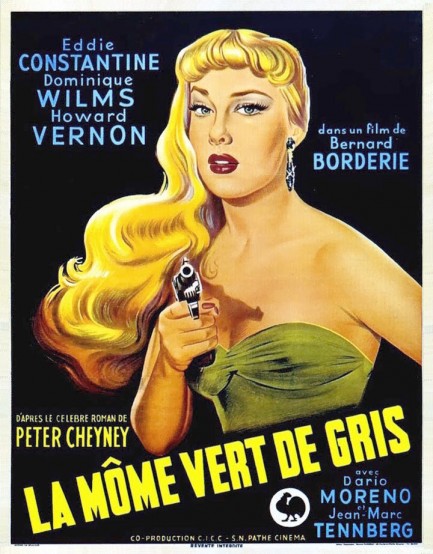 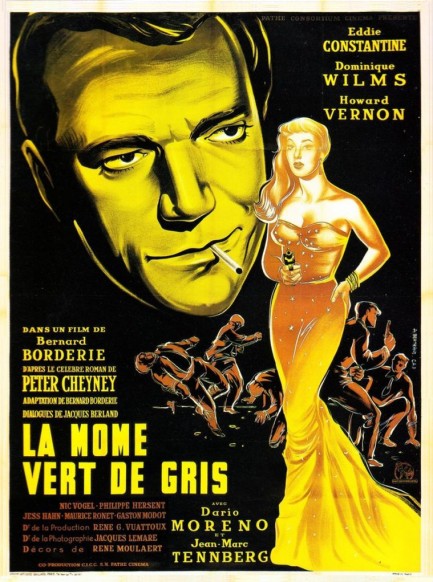
Here you see two posters for the 1953 French crime drama La môme vert de gris, which was called Poison Ivy in the U.S. This was adapted from a 1937 novel by Peter Cheyney that featured his recurring character FBI agent Lemmy Caution, who onscreen is played by Eddie Constantine. When two million dollars worth of gold goes missing Constantine is sent to Casablanca to determine its disposition and identify all malefactors involved. He finds himself pitted against a criminal mastermind of sorts, and a hive of henchmen that occupy a nightclub, a yacht, and a hideout in Casablanca's old quarter. Constantine deals with all comers by applying the time-honored advice: when in doubt, punch them out.
Film buffs the world over associate Casablanca with the Humphrey Bogart film of the same name, but the city you see here is different from the one made famous by Bogart and Co. ten years earlier. The Casablanca of this film is a maze of L.A.-style roads, white skyscrapers, and an industrial port the size of Long Beach. We checked population figures and learned it was already a major city of more than 500,000 people during the early 1940s, which means that Casablanca's village feel is really just a clever cinematic fantasy. Poison Ivy's Casablanca is real, and the many location shots mixed into the movie prove it.
That's Dominique Wilms on the top poster, and she's the reason we watched the movie. In this, her cinematic debut, she plays a femme fatale named Carlotta de la Rue, which of course indicates that she's a woman from the street. If that isn't enough to warn the men away, her friends call her Poison Ivy. Why? Because she burns. Hopefully that's meant figuratively, and above the waist. A character bringing so much heat must of course perform a torch song, which she sings with detachment, while the lyrics—as they usually do—indicate deeper issues: “I wander with my sorrow, along with my memories, looking for my old joys, which I've seen fade and die.” See? She just wants to be loved, assuming a man isn't thwarted by her acid tongue, that ironic right eyebrow, and the barbed wire encircling her heart.
The movie is certainly watchable, though it's nothing special aside from its exotic setting. But you have to appreciate the French love for U.S. crime fiction. In fact, director Bernard Borderie got the band back together and cast Constantine, Wilms, and her prehensile eyebrow in the next Caution movie, 1954's Les femmes s'en balancent. Constantine and Wilms also co-starred in 1957's Le grand bluff, another Caution adaptation, but helmed by Patrice Dally. Constantine went on to make Caution the signature character of his career. Wilms, who at age ninety is still out there somewhere, had about a dozen more roles before leaving cinema behind, but we think she had “it,” and will definitely check out some of her other work. 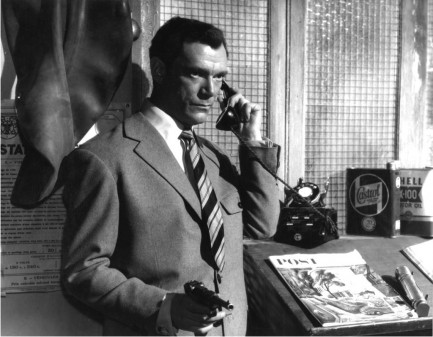 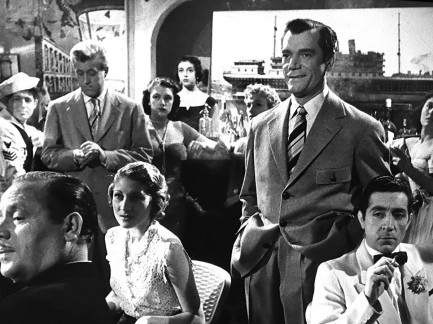 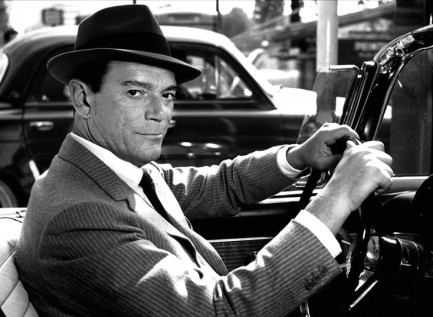 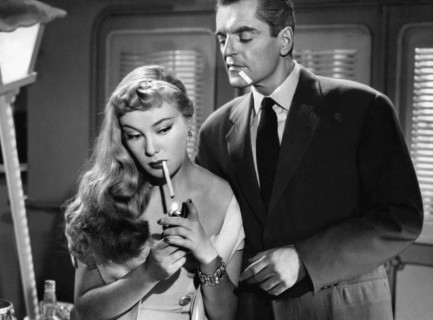 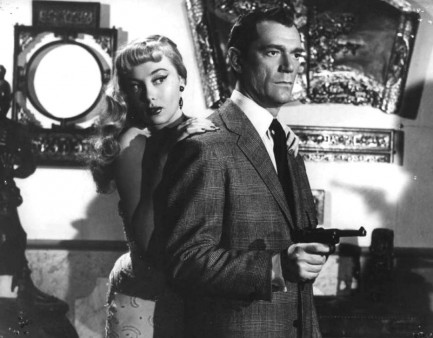 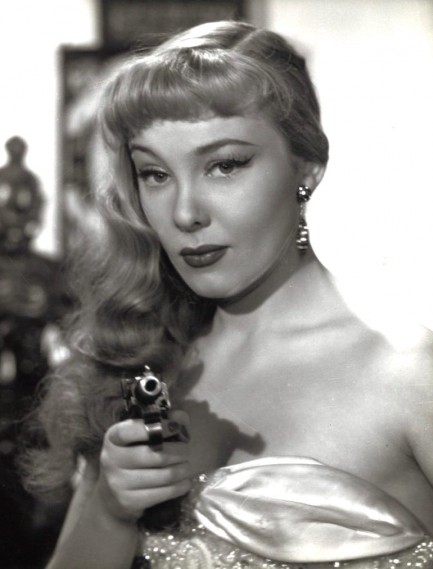 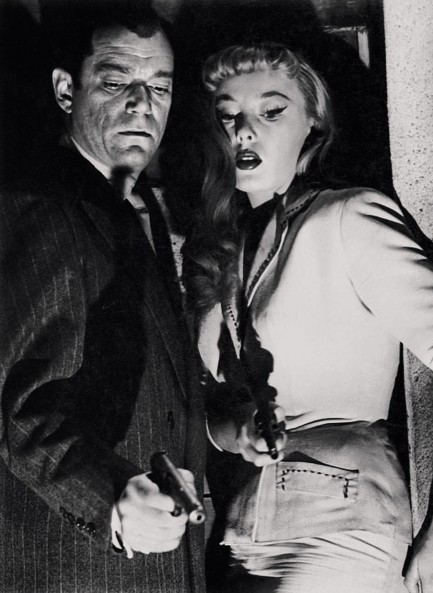 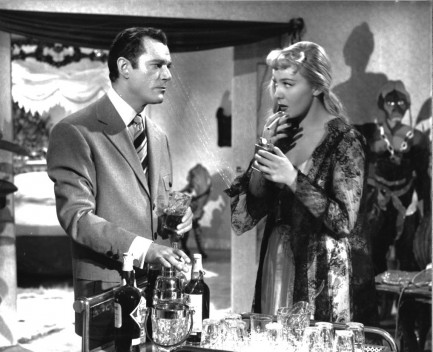 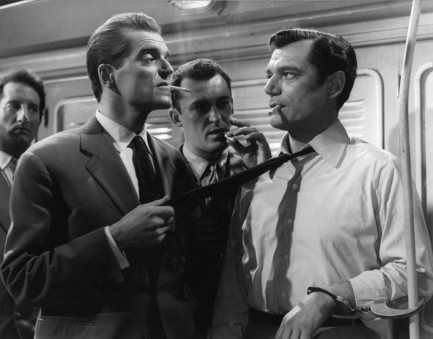 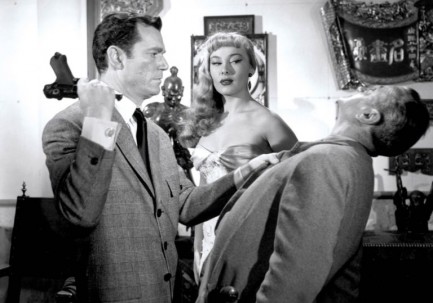 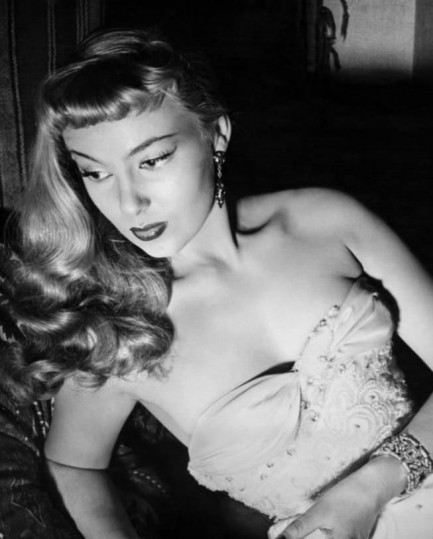
 Bogart didn't deserve me anyway. 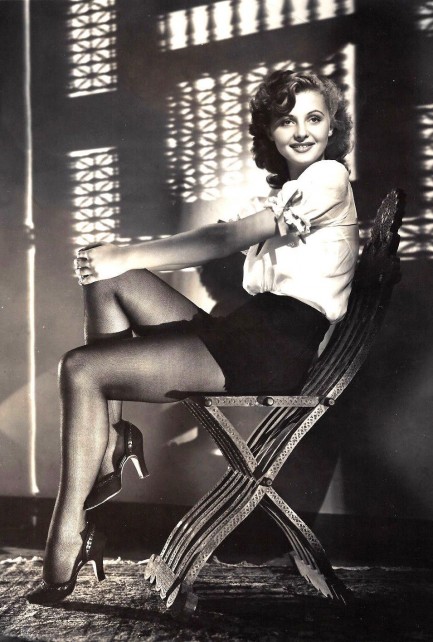
French actress Madeleine Lebeau made more than thirty films, including Federico Fellini's classic 8½, but we remember her most for her small part in Casablanca. You remember too. She's badly treated by Humphrey Bogart in the beginning of the film, but we see her later as she joins bar patrons drowning out Nazi soldiers who are singing “Die Wacht am Rhein” by singing an even louder rendition of the French national anthem “La Marseillaise.” She's the one in tears. It's an unforgettable image in an unforgettable movie and remains Lebeau's trademark screen moment. This photo is a promo from Casablanca made in 1942.
 The fundamental things apply as time goes by. 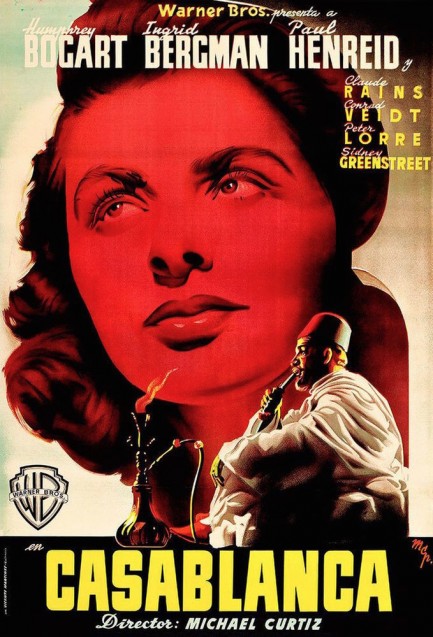
Yes, we're back to Casablanca. Above you see a Spanish poster for this award winning war drama, which premiered in Madrid today in 1946. The movie was a smash hit everywhere because, simply put, it dealt with every important theme in the realm of human experience, which is why it's still fundamental viewing. And that would be true even if most of the characters weren't migrants—a type of person that's very prominent in the news these days.
The poster art is signed MCP, the designation applied to work produced by the Barcelona based design company owned by artists Ramón Martí, Josep Clavé, and Hernán Pico. We'll get back to this trio's output a bit later. Casablanca generated some very nice promos, and MCP's effort is one of the best, in our opinion. We also recommend checking out the Japanese ones here.

|
 |

The headlines that mattered yesteryear.
2003—Hope Dies
Film legend Bob Hope dies of pneumonia two months after celebrating his 100th birthday. 1945—Churchill Given the Sack
In spite of admiring Winston Churchill as a great wartime leader, Britons elect
Clement Attlee the nation's new prime minister in a sweeping victory for the Labour Party over the Conservatives. 1952—Evita Peron Dies
Eva Duarte de Peron, aka Evita, wife of the president of the Argentine Republic, dies from cancer at age 33. Evita had brought the working classes into a position of political power never witnessed before, but was hated by the nation's powerful military class. She is lain to rest in Milan, Italy in a secret grave under a nun's name, but is eventually returned to Argentina for reburial beside her husband in 1974. 1943—Mussolini Calls It Quits
Italian dictator Benito Mussolini steps down as head of the armed forces and the government. It soon becomes clear that Il Duce did not relinquish power voluntarily, but was forced to resign after former Fascist colleagues turned against him. He is later installed by Germany as leader of the Italian Social Republic in the north of the country, but is killed by partisans in 1945.
|

|
|

It's easy. We have an uploader that makes it a snap. Use it to submit your art, text, header, and subhead. Your post can be funny, serious, or anything in between, as long as it's vintage pulp. You'll get a byline and experience the fleeting pride of free authorship. We'll edit your post for typos, but the rest is up to you. Click here to give us your best shot.

|
|

















 clientele, and the aura of being in the middle of a spy caper. The decadent colonial bar Abaco, located in Palma de Mallorca, comes immediately to mind, as does the supper club Meson Pansa Verde in Antigua, Guatemala, where they have live jazz in a converted wine cellar and a friend of ours once famously pushed his date into the pool. We've been to Rick's-like places in Mexico, the Caribbean, the Greek Islands, and, appropriately, Morocco, in both Fes and Marrakech (we're not fans of the Rick's that currently operates in Casablanca—same name, very diminished feel). But magical places do exist, which means even if Bogart's beloved café was never real, having those types of nights is possible. We recommend making it your mission to seek them out.
clientele, and the aura of being in the middle of a spy caper. The decadent colonial bar Abaco, located in Palma de Mallorca, comes immediately to mind, as does the supper club Meson Pansa Verde in Antigua, Guatemala, where they have live jazz in a converted wine cellar and a friend of ours once famously pushed his date into the pool. We've been to Rick's-like places in Mexico, the Caribbean, the Greek Islands, and, appropriately, Morocco, in both Fes and Marrakech (we're not fans of the Rick's that currently operates in Casablanca—same name, very diminished feel). But magical places do exist, which means even if Bogart's beloved café was never real, having those types of nights is possible. We recommend making it your mission to seek them out.






















